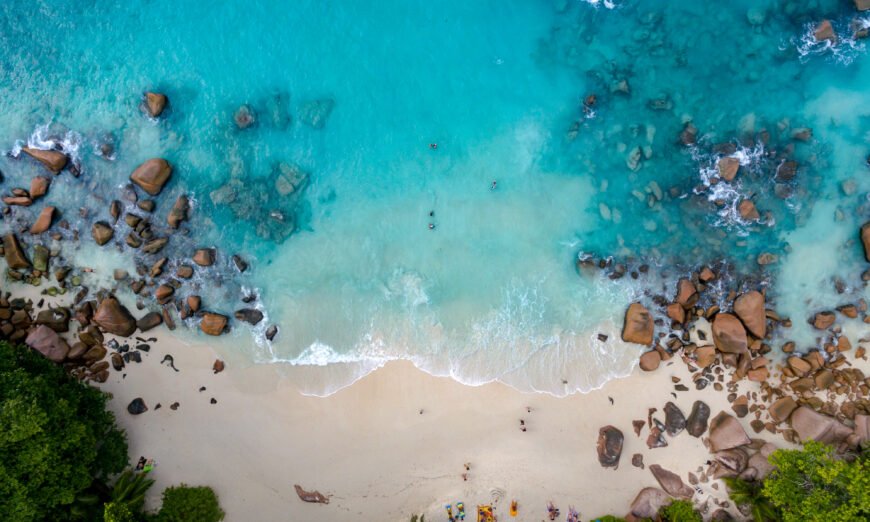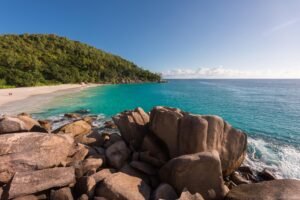
In terms of population and physical size, Praslin is the second-largest island in the Seychelles with around 8,000 permanent residents. Mahé, by comparison, is the most heavily-populated with around 77,000 inhabitants. Offering the second-highest amount of holiday accommodation in the Seychelles as well, Praslin welcomes tourists from around the world, who come here to enjoy the unique vegetation, the beautiful beaches, and the crystal-clear water that surrounds the island. Politically, Praslin is divided into two districts: Grand Anse and Baie Sainte Anne. Public transport is well-organized, and tourists are offered a variety of options. Since the main revenue of the island is tourism and travel, localites go the extra mile to make sure that tourists feel welcome and comfortable.
The usual way to reach Praslin is by means of a propeller aircraft from Mahé, which only takes a fifteen-minutes. The islanders, besides tourism, make a living from agriculture and fishing. Praslin is thankfully not particularly crowded, and has managed to retain its charm, ensuring that anyone who loves peace and nature will certainly want to come here during their stay. There are many views to enjoy, especially during a hike or tour, which will take your breath away. These include fine, sandy beaches with crystal-clear water, dense jungles, palm trees, takamaka trees, waterfalls, and much more. Compared to Mahé, the island consists more of rolling hills than towering mountains, with Praslin’s maximum elevation, the Fond Azore, reaching just 367 metres. This however has the added bonus that it does not rain as much on Praslin as it does on Mahé.
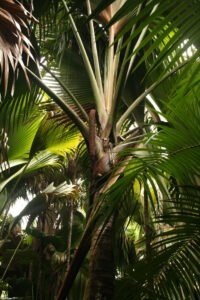
The shallow St. Anne Bay is home to a small port that serves the ferry services from Mahe and La Digue. In the same town, two kilometres north of the landing point, there are churches, hospitals, banks, a post office, a gas station, and a school, mini markets, and car rentals. The majority of accommodation on Praslin consists of large hotels. It is named after the patron saint of the first Catholic Church on the island, St. Anne.
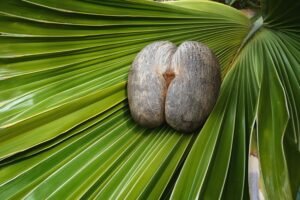
Extensive land reclamation efforts were conducted in this bay in the past, something that was also carried out on Mahé. The artificially-reclaimed island was, in this case, named “Eve Island”, and was connected by bridges to Praslin.
The island’s main attraction is the UNESCO World Heritage Vallée de Mai, a first-class botanical sensation containing the aforementioned Coco de Mer, which attract many visitors on a daily basis. A walk through the jungle-esque park leaves you with a taste of how the island’s first visitors might have felt. Besides plants, rare birds such as the Raven Parrot call this reserve their home.The north-east and the west coasts of the island are protected by extensive coral reefs and boast long, sandy beaches.
The “Heart of Praslin” is home to remnants of the original palm jungles of the Seychelles and has often been described as a “Garden of Eden” thanks to its secluded and mystical nature. The park was placed under protection as far back as 1966, with over 1,400 trees of the legendary Coco de Mer falling under the protection of the Seychelles Government due to their uniqueness and that of the location.
The Coco de Mer only grows naturally on the islands of Praslin and Curieuse. The oldest specimen of the tree is around 300 years old and 27 m high, with a perfectly straight trunk and large, fan-shaped leaves. The female tree produces a heart-shaped fruit of up to 25 kg, the largest and heaviest seeds in the world. Because of its distinct shape, reminiscent of a woman’s pelvic region, the seed once enjoyed a reputation as a coveted treasure in former royal courts. However, the Coco de Mer palm is now endangered and on the World Conservation Union’s (IUCN) Red List, with numbers falling around 30% in the last 50 years alone. The Vallée de Mai is also home to the rare Black Parrot, of which there are three species in the Seychelles and one more sub-species in Madagascar. The birds are very shy and usually can only be heard.
Although the Vallée de Mai is, of course, the main attraction on Praslin, an exciting alternative that is well-worth visiting is the Fond Ferdinand Nature Reserve. Only opened in 2013, the park is naturally not yet very widely-known. The starting point can be found thanks to a small, red/white sign in the car park at Anse Marie-Louise. Besides the winding path through the valley, the two or three-hour journey up to the viewpoint is well-worth a trip too. From this point you can enjoy a beautiful view of Praslin itself, as well as the other inner islands of the Seychelles. There is an equally-breathtaking panoramic view from Zimbabwe point. This spot in the north-west of the island is particularly nice at sunset. From Anse Boudin, drive up the road towards Zimbabwe until you reach the gates of a transmitting station. From here, you can head north to Aride, look west at Cousin and Cousine island, and east to Curieuse. La Digue and its surrounding islands can be seen to the south.
From Praslin, you can reach around twenty diving sites. There are a variety of long and short-range dives that you can find at the different diving centres for different prices. Diving from Praslin is slightly different from on Mahé. The tide is often higher, the fish larger, and the dives more adventurous. The tiny island of St. Pierre is a beautiful diving site at the heart of the Curieuse Marine Park. It can be reached by boat from the Côte d’Or in a few minutes. Here you can see beautiful, lush shoals at depths of up to 12 metres. The Sister Reef does not exceed 24 metres in depth, and offers a unique diving experience with amazing rock formations and many fish. You may even see grey reef sharks, yellow fin tuna fish, and stingrays.
South Marianne Island is perhaps the best diving spot in the Seychelles’ Inner Islands, with an overwhelming variety and quantity of fish! Amongst others, grey reef sharks, eagle rays, turtles, barracudas, giant moray, and jackfish swim at this location. The journey to South Marianne takes about 30 minutes from the Côte d’Or, which can be slightly difficult for those who get seasick easily (depending on sea conditions). On the way, however, you are treated to views of Ave Maria, Coco Island, Grande and Petite Soeur, La Digue, and Félicité. Upon arrival, visitors are immediately greeted by various rock formations. The maximum depth here is 25 metres, and, as a word of warning, the currents are occasionally quite strong.
Anse Boudin is an interesting beach in the north-east of Praslin, looking out over the ocean to Curieuse Island. With a good mix of facilities, local activity, and beautiful scenery, it’s well-worth a visit for anyone on Praslin. The water here is extremely shallow, especially at low tide, although it does deepen quickly away from the sandy areas of the beach. Getting to the beach is simple thanks to the nearby road, which has space for parking, as well as bus stops for those who don’t wish to rent a car. Naturally, visitors can also come on-foot, especially if their accommodation isn’t too far away. Perhaps the most striking thing about Anse Boudin once you arrive is the local activity here.
Fishermen often leave their boats anchored in the shallow water here, so you can normally spot a few small boats in the bay. As well as that, on Saturdays, the locals sometimes play football on the beach, which is worth seeing if you like sports. The shallow water of the beach lends itself well to snorkelling and swimming, and the water is even safe for children to swim and play in.

